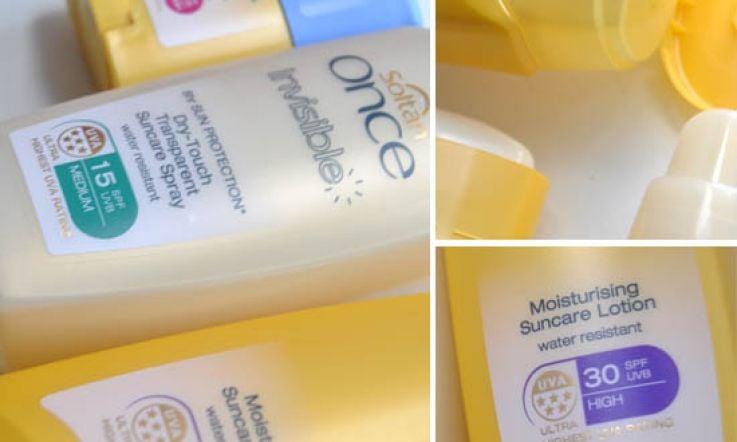Summer SPF and Suncare Questions Answered by Boots Suncare Scientific Adviser, Mike Brown, Part 2

On Friday we had part one of our Summer SPF and suncare questions via Twitter, as answered by Boots suncare scientific sdviser, Mike Brown. There were quite a lot of 'em, so today we're taking a shot at part two. Lets go:
@Enaregina whats the best face cream? and what factor should you wear? I'm white as white can be
"Soltan Face is great," Mike enthuses. "Give it a go - ok, I know I'm bound to say that - but it has a beautiful texture and no greasiness."
@dubdot Am big fan of No7 Anti-Dark Spot SP 30+ and 50+ but why do they smell faintly of wee? Hubby always complaining bout smell!!
"Thank you for the feedback!," laughs Mike. "We'll look into that!"
@The_Licentiate Are there any SPF products specifically for hands? Normal sunscreen is a wee bit too greasy for me.
Advertisement
This is another easy one. No7 released a Protect and Perfect Handcream with SPF15 in January which is worth a look. It ticks all the boxes for anyone looking for care product for paws with that all-important sun protection factor built in. You can of course mix a little factor 50 into your regular hand cream to give some protection too.
@manninge How often should we re-apply? And are waterproof creams really as effective after swimming?
"When you're on holidays and out in the sun, re-apply every one-to-two hours," says Mike. With regards to water, most products are marketed as water 'resistant' and not water 'proof', but the real test of them comes when towels get involved, he reveals. So that's why you really need to reapply after swimming. It's not the water that'll take the product off - sunscream is designed to be somewhat adherent to skin - but drying yourself off after bathing will lift the cream off with it. "Soltan suncream is designed and tested to give protection for about 40 minutes of swimming," he says.
The exception to re-application every couple of hours rule is a product in the Boots range called Soltan Once Invisible. This has the same sort of technology in it that long-wear makeup does, so it uses, Mike says, "a polymer like an interlocking matrix." This is sprayed onto the skin, where it sits until you remove it, and gives eight hours of protection. If you're swimming, then the rules change and you need to reapply post-towelling.
Now, that all sounds great in theory but I hate longwear makeup personally because it's awful horrid stuff on my dry skin - and as Mike told me himself, while this doesn't contain anything to dry out your skin, equally, it contains nothing to moisturise it, so be aware of that before you buy. Those eight hours come with a trade off!
@jilloherlihy What is best suncream for littlies and is there one that will suit a one year old and four year old that is waterproof?
Advertisement
What some soon-to-be and new mums might not know is that there's a very good reason to keep infants out of the sun - their skin's barrier hasn't yet fully formed so they shouldn't be exposed to UV rays. When they're older, they need protection too. Mike recommends you go for a high factor and try the Soltan Kids products.
Again, while there aren't water'proof' SPFs on offer, there's a new product in the range, Soltan Once Kids Waterplay SPF50, which has been tested thoroughly and even after three hours immersion, the SPF remained stable and as stated on the pack. So, it could be a good one to try.
@bioniclaura Do you need a higher spf when pregnant?
"No, you don't need any special products when pregnant," he confirms. Even though the skin will thin slightly towards the end of pregnancy, the UV rays will never penetrate into the womb. What about conditions like Melasma, which cause pigmentation on the face, the bane of many a pregnant woman? "Again, no," says Mike. "These are hormone-led and nothing to do with sun exposure."
@leonarddaly are all the products full spectrum??
One of the good things about the Soltan range is how it's demystified the whole UVA and UVB thing for consumers. There are EU guidelines for sunscreens and most brands follow them - sunscreens produced in the EU in general are very good and conform to guidelines. But sunscreen maths is FIERCELY complex and vis a vis the guidelines, most products tend to include UVA protection (the protection against the rays that age) as a lesser ratio compared to the UVB protection (the protection against the rays that burn). Now, I am wildly over-simplifying: it's not a direct comparison in actual fact, but as we're not all skincare scientists it'll suffice in explanation terms.
Hard as it is to get the technicalities, Boots pushed them to one side and brought in a star system. I think we can all agree that ideally, it would be great if our sunscreen products provided a relatively equal proportion of protection against both types of ray, am I correct? So they set upon a system to reflect that. It's not always possible in formulation terms to achieve it but in newer products they are doing it - when you see a five star rated SPF product in the Soltan range, you know it contains the best possible level of protection against both UVA and UVB rays.